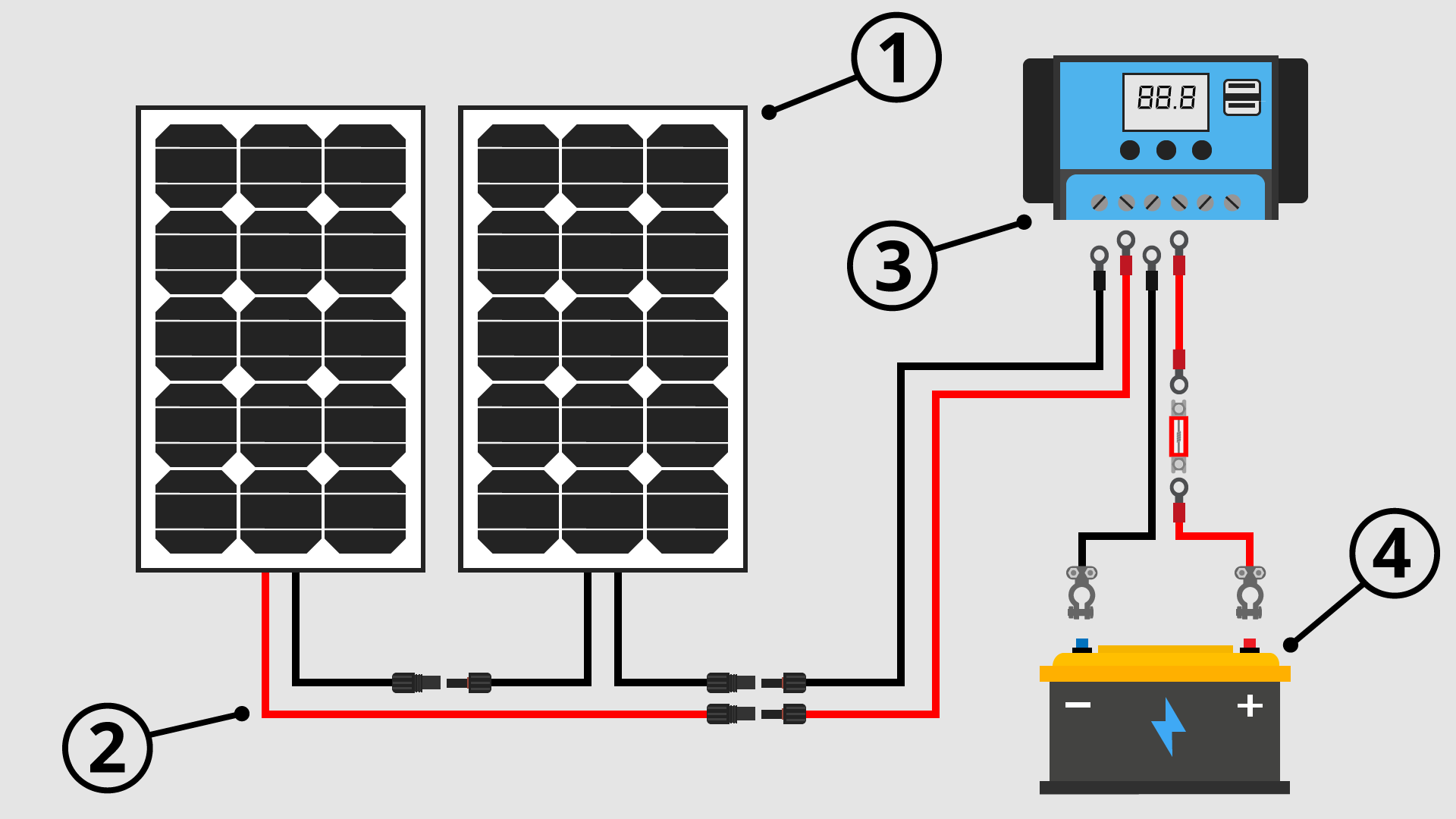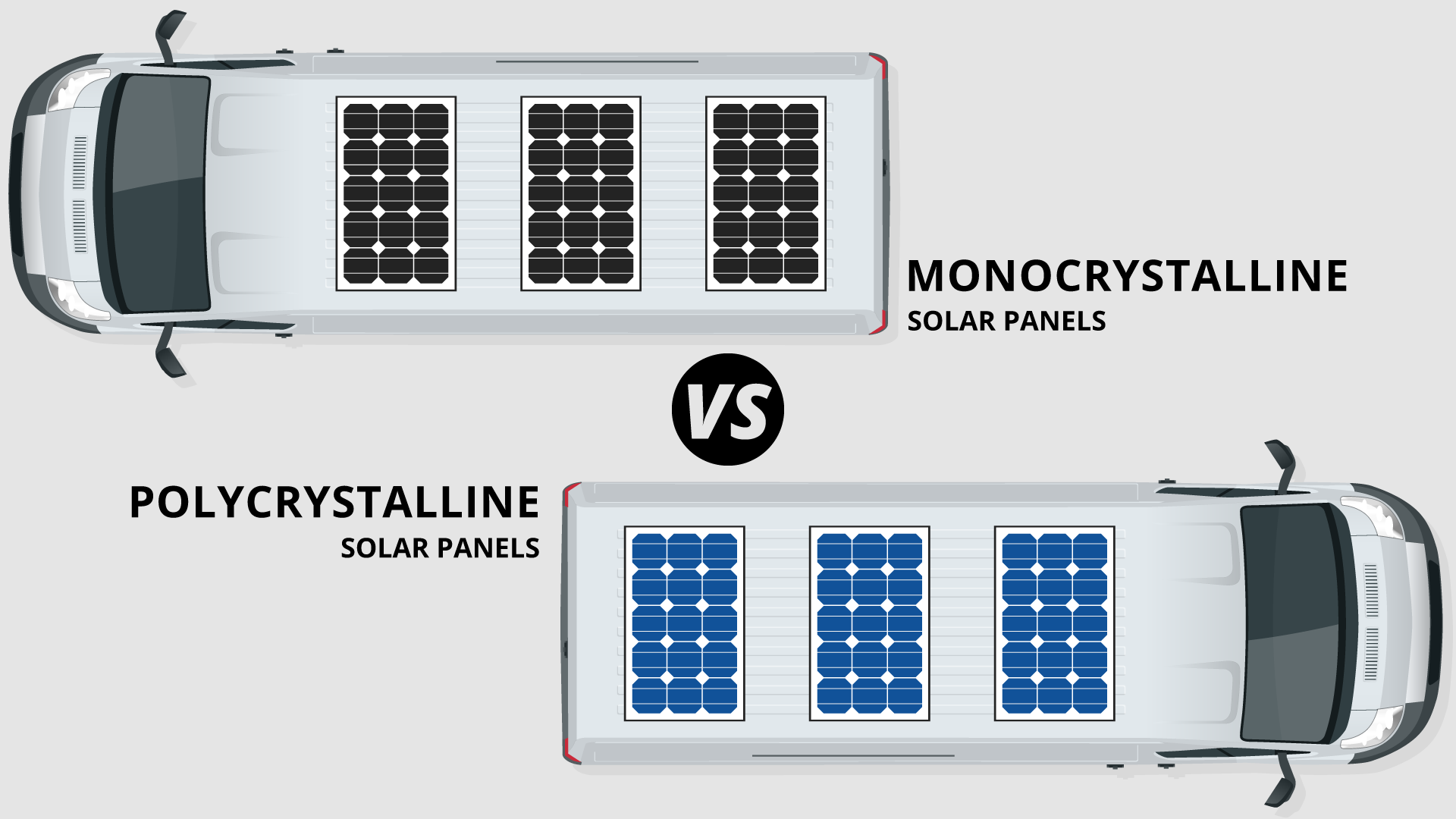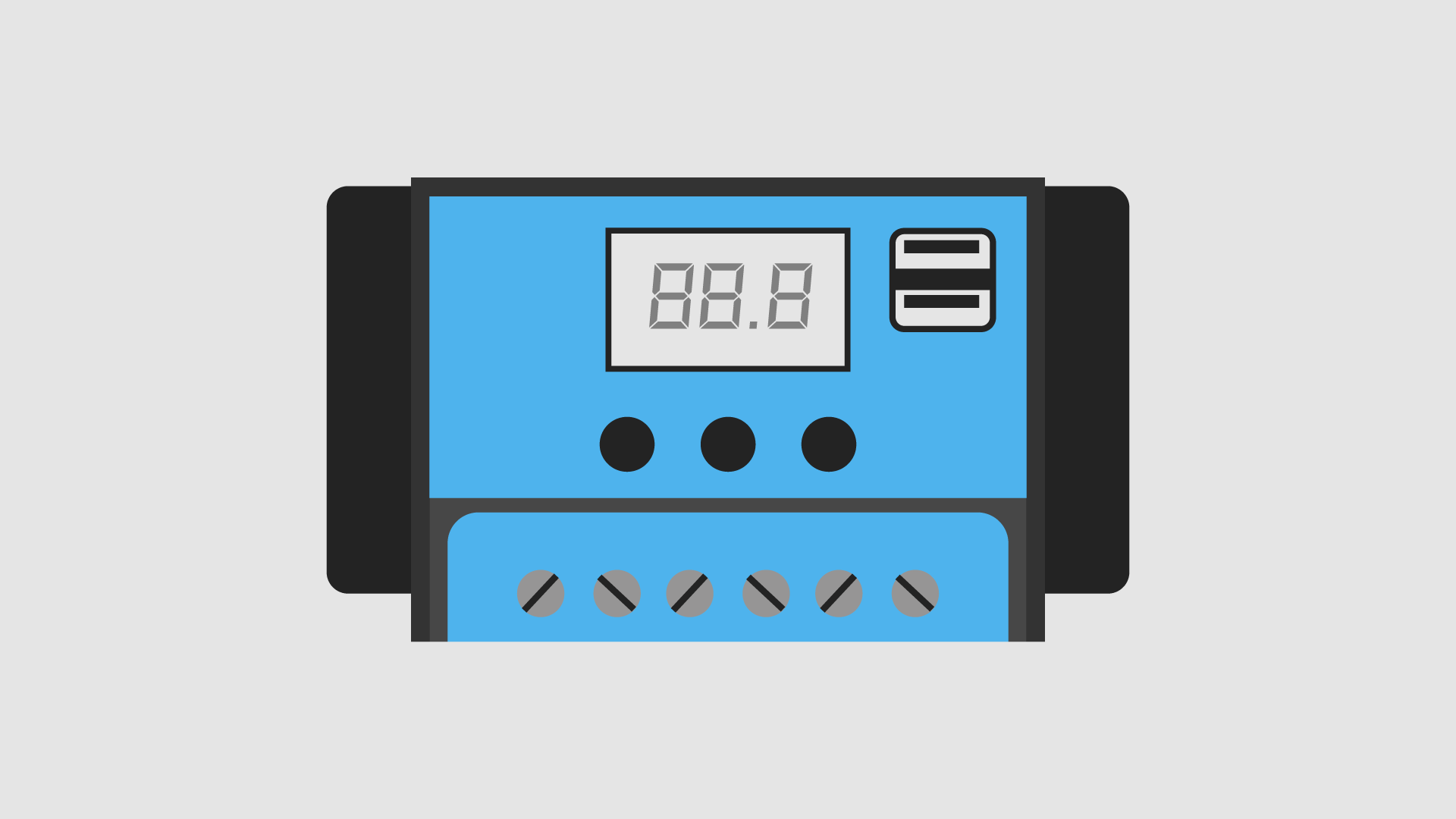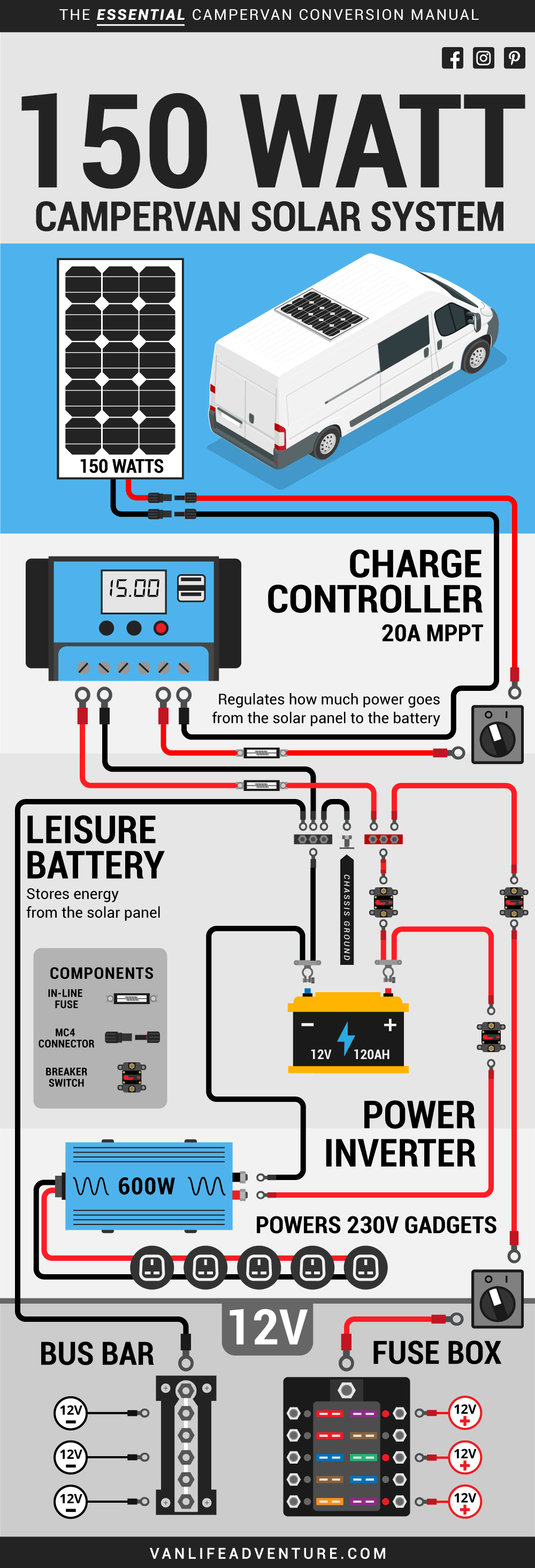- Arron
- Updated: 21st March 2023

Thanks to rapid technological advancements, installing solar panels on a campervan, is now more than ever, an excellent way of generating additional power.
There is also the green credentials. Many of us want to decrease our use of fossil fuels (both through the national grid and/or fuel-powered generator).
By installing a solar power system into your campervan, you can harness the power of the sun and store it in your leisure battery. This energy can then be used when you turn on an appliance and/or gadget.
How Does A Solar Power System Work In A Campervan?

A typical campervan solar power system is comprised of four main electrical items.
1. Solar Panel. The primary purpose of a solar panel is to generate electricity. This is achieved by turning particles of sunlight into electricity. The primary purpose of a solar panel is to generate electricity. This is achieved by turning particles of sunlight into electricity.
2. Wiring. The primary purpose of the wiring is to enable the transfer of electricity created from the solar panel to additional devices and power storage components. To connect a cable to a solar panel correctly, you use an MC-4 connection terminal.
3. Charge Controller. The primary purpose of a solar charge controller is to regulate the incoming voltage/current from your solar panel. This device helps prevent any potential issues that may damage your solar charge system.
4. Leisure Battery. The primary purpose of a leisure battery is to efficiently store electricity created by a solar power system. This electricity can then be used later on.
Part 1: Solar Panels

How does a solar panel work?
A solar panel works by capturing the energy coming from the sun and turning it into electricity that can then be used for your campervan.
- Photons from the sun collide with solar cells inside a solar panel. A typical 14.72-volt solar panel has 32 solar cells.
- The photons knock the electrons loose from their atoms inside each of the solar cells.
- Conductors attached to both the positive and negative sides of each solar cell forms an electrical circuit.
- When the sun is shining, electrons start to flow through the circuit, creating electricity.
What are the two main types of solar panels used in a campervan?
The two main types of solar panels used in a campervan are Monocrystalline Solar Panels and Polycrystalline Solar Panels. These panels are both an excellent choice for your campervan solar installation. However, its worth noting that there are a few key differences between the two types of solar panels that you should first be aware of before making your final decision.
What are the main differences between a monocrystalline & polycrystalline solar panel?

Monocrystalline Solar Panel
- Monocrystalline solar panels have solar cells made from a single crystal of silicon. As a result, these panels are slightly more efficient compared to a Polycrystalline solar panel.
- Floor space required for Monocrystalline solar panels is usually less compared to a Polycrystalline solar panel to produce the equivalent power output.
- The surface of Monocrystalline solar panels generally has a black hue.
- These panels are generally more expensive compared to Polycrystalline.
Polycrystalline Solar Panel
- Polycrystalline solar panels have solar cells made from many silicon fragments that are then melted together. As a result, these panels are slightly less efficient compared a to Monocrystalline solar panel.
- Floor space required for Polycrystalline solar panels is usually more compared to a Monocrystalline solar panel to produce the equivalent power output.
- The surface of Polycrystalline solar panels generally has a blue hue.
- These panels are generally less expensive compared to Monocrystalline.
What are the best solar panels for my campervan?

When selecting the type of solar panel to install in your campervan, this will ultimately come down to your budget. Monocrystalline solar panels are a little bit more expensive compared to Polycrystalline panels.
Recommended Products
| Image | Brand | Power | Type | Technology | Buy |
|---|---|---|---|---|---|

|
Renogy | 100w | Fixed | Monocrystalline | Check Price |

|
Eco Worthy | 120w | Fixed | Monocrystalline | Check Price |

|
Renogy | 100w | Flexible | Monocrystalline | Check Price |
Part 2: Solar Panel Wiring

How do I wire solar panels in my campervan?
When it comes to wiring your solar panels to your campervan, you generally have two options. (Well, you actually have three, but we will get to that later)
You can wire your solar panels in a series or parallel format.
Wiring In Series

When the solar array is wired in series, all solar panel acts as one entire unit. This is done by connecting the positive terminal of the first solar panel to the negative terminal of the next one.
Connecting them in this way will increase the total voltage generated from a solar array & the amperage will stay the same.
Advantages of wiring solar panels in series
- Higher power output under ‘normal’ circumstances.
- You will require wiring with a less significant gauge due to the lower amperage.
- You will require less wiring.
- The distance from the solar panel to the charge controller will be less critical.
Wiring in Parallel

When the solar array is wired in parallel, each solar panel acts as an independent unit. This is done by connecting all positive terminals of all the solar panels together, and all the negative terminals of all the panels together.
Connecting them in this way will increase the total amps generated from a solar array & the voltage will stay the same.
Advantages of wiring solar panels in parallel
- Performs better when one of the solar panels is dirty/in the shade/broken.
Should I wire my solar panels in series or parallel?
This is really not a question we can answer as this will ultimately come down to your personal preferences.
How do I connect the solar panels between each other?

The most common way of connecting solar panels to one another is via a watertight connection plug known as an MC4 Connector. However, some installers simply cut and join their wires using more primitive ways (junction boxes, spline and solder).
By using an MC4 connector, this can make installation a lot easier and safer. Another benefit of using MC4 connectors is that it can make it a much simpler process if you ever need to remove your solar panel for maintenance/cleaning.
What are the best cables for for my campervan solar power system?
Here is our list of what we believe are the best cables when installing your solar panel system aboard your campervan.
| Image | Brand | Length | Gauge | Buy |
|---|---|---|---|---|

|
Tramily | 5M | 10AWG | Check Price |

|
Proster | 10M | 10AWG | Check Price |
Part 3: Solar Charge Controller

Overview
Now you have the solar panels (solar array) fitted to your campervan, you should now be able to produce power. But, simply connecting the solar array directly to the battery bank is not the correct way.
As mentioned above, the energy being produced from your solar array will fluctuate quite a fair bit. To control the fluctuation, you will have to run the power through a charge controller.
What does a solar charge controller do?

A charge controller (or sometimes referred to as a charge regulator) is an electronic device that regulates the voltage and/or current that comes from the connected solar array (panels on the roof of the van) to the battery bank (leisure battery).
As a typical leisure battery needs around 13.8 to 15.5 volts to fully recharge. As a result, when operational and receiving input power from solar panels, a typical charge controller will output between 10.5 to 15 volts.
However, the output voltage can fluctuate. This all depends on:
- The state of charge of the leisure battery.
- The type of battery.
- What mode the charge controller is operating in.
- Overall temperature.
Why do I need a solar charge controller?

If you connected your solar array directly to the battery bank, you could be in for some major trouble.
Batteries have a specified voltage capacity. If you exceed that recommended voltage, you will expose the battery bank to numerous overcharges and over discharges. This would dramatically reduce the lifespan of the batteries – or even worse, result in an electrical fire!
Are there different types of charge controllers?

There are two types of solar power charge controllers. They are:
- Pulse Width Modulation (P.W.M.) Charge Controllers
- Maximum Power Point Tracking (M.P.P.T.) Charge Controllers
What’s the difference between a P.W.M. controller and an M.P.P.T. controller?
Without going too much into detail, these are the basic fundamentals for each of the controllers:
Pulse Width Modulation (P.W.M.) Charge Controller
A P.W.M. controller is the more basic of the two controllers. They match the solar array voltage to the voltage required to charge the batteries.
- The way a P.W.M. controller works is by simply turning on and off (hence called pulse rate modulation).
- When the P.W.M. controller is on, it will send power to the batteries.
- When the P.W.M. controller is off, it will monitor the capacity of the batteries making sure to properly charge the batteries throughout the full state of charge.
- A P.W.M. controller is around 10% – 40% less efficient when compared to an M.P.P.T. controller.
- A PVM controller can cause interference to the on-board radio equipment. This is due to the sharp pulses generated for the battery bank charging.
- A P.W.M. controller generally tends to be around half price or less.
Maximum Power Point Tracking (M.P.P.T.) Charge Controller
- The added functionality of an M.P.P.T. charge controller is that it can electronically track and deliver the most optimal amount of power coming from the solar array to the battery bank.
- If the output voltage of the solar array (24V, 48V or more) is higher than the battery bank voltage (which is usually 12v), the controller will intelligently bring the power down to the optimal charge voltage. This is generally between 13.8v to 15v. The controller will also compensate for the ‘drop’ by increasing the current.
- As with the P.W.M. controller, the M.P.P.T. charge controller can monitor the capacity of the batteries, and then match the necessary voltage required to charge those batteries.
- Another benefit of an M.P.P.T. controller is a reduction of the wire size (gauge) needed when connecting a solar array that is connected in series. This is due to the higher voltage/lower current coming from the solar array.
- An M.P.P.T. controller is around 10% – 40% more efficient when compared to a P.W.M. controller.
- An M.P.P.T. controller generally tends to be around twice the price or more (depending on technology/make).
What is the best charge controller for a campervan?
When selecting what solar charge controller is right for you will primarily come down to your budget. However, here is our list of what we fell are the best charge controllers for every budget.
| Photo | Brand | Model | Input Voltage (max) | Charge Current (max) | Battery Voltage | Buy |
|---|---|---|---|---|---|---|

|
Victron | 100 | 20 | 100V | 20A | 12/24V | Check Price |

|
Victron | 150/35 | 150V | 35A | 12/24V | Check Price |

|
Renogy | Rover | 100V | 40A | 12/24V | Check Price |
Complete Campervan Solar Power System
Here we have created what we believe is the best system you can install in your campervan. We constantly update each product to what we feel are the very best in the current market.

Key Parts
| Photo | Category | Product | Buy |
|---|---|---|---|

|
Solar Panel | Renogy 175W Solar Panel | Check Price |

|
Charge Controller | Victron SmartSolar 75/15 MPPT | Check Price |

|
Fuse Box | Generic 6-Way Fuse Box | Check Price |
Accessories
| Photo | Item | Buy |
|---|---|---|

|
Eco-Worthy Mounting Brackets | Check Price |

|
Sikaflex 522 Bonding Glue | Check Price |

|
Nitrile Gloves | Check Price |
Key Items
| Photo | Category | Item | Quantity | Buy |
|---|---|---|---|---|

|
Solar Panel | Renogy 175W Solar Panel | 2 | Check Price |
Accessories
| Photo | Item | Buy |
|---|---|---|

|
Eco-Worthy Mounting Brackets | Check Price |

|
Sikaflex 522 Bonding Glue | Check Price |

|
Nitrile Gloves | Check Price |
Key Items
| Photo | Category | Item | Quantity | Buy |
|---|---|---|---|---|

|
Solar Panel | Renogy 175W Solar Panel | 3 | Check Price |
Accessories
| Photo | Item | Buy |
|---|---|---|

|
Eco-Worthy Mounting Brackets | Check Price |

|
Sikaflex 522 Bonding Glue | Check Price |

|
Nitrile Gloves | Check Price |
Solar Power Tips and Tricks

- Even the smallest shadow can affect the amount of power generated by a solar panel. Always ensure as much of the panel is in direct sunlight.
- Try and park your campervan so your solar panels will catch as much of the midday (strongest) sunlight as possible. In the summer, this usually is directly overhead. Remember trees and tall buildings too!
- Before you head out and buy your brand new solar panels, make sure they will actually fit on top of your campervan. This may sound so obvious, but this is one of the most significant errors people often make when they purchase solar panels for their campervan. You may also need to purchase special adapters.
- Make sure you carry out regular leisure battery maintenance. For example, a poorly maintained battery will affect how well your solar panels effectively charge them back to the optimal capacity.
- Try and replace any electrical items inside your campervan with the equivalent energy-efficient ones. Think halogen bulbs to LEDs. By doing so, you can drastically reduce the power you consume, meaning your solar panels won’t have to work as hard.
- Remember: Pollution, dust, tree gunk and bird droppings can reduce the amount of sunlight hitting your solar panels. Remember to regularly clean your solar panels with soap and warm water to remove any build-up of dirt. This should keep your panels as efficient as possible. This is also one of the most common issues people will find when they first install solar panels on the van.
Did you find this guide useful?
Thank you for reading our highly detailed guide! We hope it was informative and helpful. If you enjoyed the content and found it useful, we would greatly appreciate it if you could leave a quick review to let us know your thoughts. Your feedback helps us improve and continue creating valuable content for our readers. Alternatively, if you feel inclined, you could also support us with a small donation. As a small independent website, every contribution helps us continue our work and keep creating quality content. Thank you for your support!
The whole process takes less than 60 seconds and directly supports VanLife Adventure.
Disclaimer
VanLife Adventure has made every effort to make sure all information displayed on this website is correct and valid. However, neither VanLife Adventure nor its employees warrants or accepts any liability for the use of any of the information presented here. The user is cautioned to seek competent engineering assistance when carrying out any installations.
- Share
- Like
- Tweet
- Pin
- Digg
- Del
- Tumblr
- VKontakte
- Buffer
- Love This
- Odnoklassniki
- Meneame
- Blogger
- Amazon
- Yahoo Mail
- Gmail
- AOL
- Newsvine
- HackerNews
- Evernote
- MySpace
- Mail.ru
- Viadeo
- Line
- Comments
- Yummly
- SMS
- Viber
- Telegram
- Subscribe
- Skype
- Facebook Messenger
- Kakao
- LiveJournal
- Yammer
- Edgar
- Fintel
- Mix
- Instapaper
- Copy Link





















